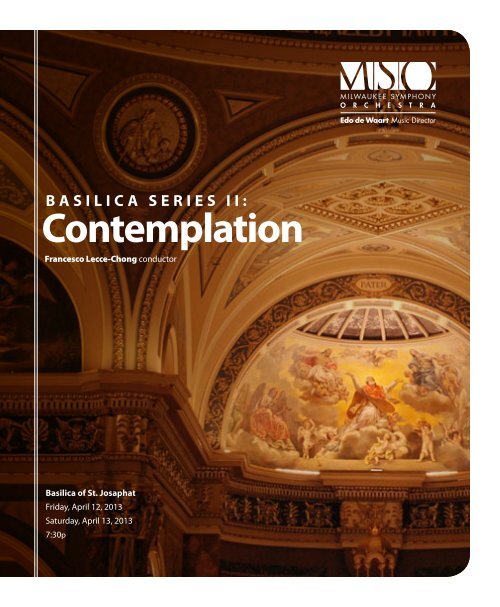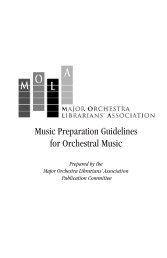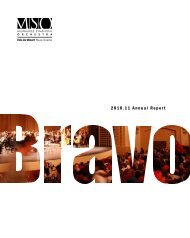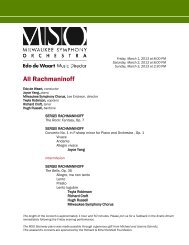contemplation - Milwaukee Symphony Orchestra
contemplation - Milwaukee Symphony Orchestra
contemplation - Milwaukee Symphony Orchestra
Create successful ePaper yourself
Turn your PDF publications into a flip-book with our unique Google optimized e-Paper software.
Basilica Series II:<br />
Contemplation<br />
Francesco<br />
Lecce-Chong conductor<br />
Basilica of St. Josaphat<br />
Friday, April 12, 2013<br />
Saturday, April 13, 2013<br />
7:30p
Basilica Series II:<br />
Contemplation<br />
Friday<br />
April 12, 2013 at 7:30 pm<br />
Saturday April 13, 2013 at 7:30 pm<br />
<strong>Milwaukee</strong> <strong>Symphony</strong> <strong>Orchestra</strong><br />
Francesco Lecce-Chong conductor<br />
Welcome<br />
Thank you for joining the <strong>Milwaukee</strong> <strong>Symphony</strong> <strong>Orchestra</strong> for our 2012.13 Basilica Series.<br />
Having had the opportunity to conduct several performances in the Basilica Series last<br />
season, I used the space itself as my primary source of inspiration in planning these<br />
concerts. When I first enter the Basilica, I am always awe-struck by the expansiveness and<br />
grandeur surrounding me. However, as I sit in quiet <strong>contemplation</strong>, the space begins to feel<br />
more intimate, and I become more aware of the sacred and profound aspects. It is amazing<br />
how such a huge external space can inspire internal reflection.<br />
With that in mind, our three programs this season explore the composer as philosopher.<br />
Most orchestral works bear such non-descript titles as “<strong>Symphony</strong>” and “Concerto,” making<br />
it easy to forget that compositions are never written solely as entertainment for the listener.<br />
Like writers and artists, every work is a composer’s personal statement. Through music,<br />
many composers comment on the philosophical issues of their days, such as the search<br />
HAYDN<br />
Intermission<br />
The Seven Last Words of Christ on the Cross<br />
Introduction<br />
Sonata I — “Father, forgive them; for they do not know what they are doing.”<br />
Sonata II — “Truly I tell you, today you will be with me in Paradise.”<br />
Sonata III — “Woman, here is your son.”<br />
Sonata IV — “My God, my God, why have you forsaken me?”<br />
Sonata V — “I thirst.”<br />
Sonata VI — “It is finished.”<br />
Sonata VII — “Father, into your hands I commend my spirit.”<br />
The Earthquake<br />
for happiness, the fear of death or the existence of God.<br />
IVES<br />
The Unanswered Question<br />
The music I have chosen for these programs reflects a great variety of styles from composers<br />
both popular and neglected, but these pieces represent some of the most intensely personal<br />
WAGNER<br />
Prelude and “Liebestod” from Tristan und Isolde<br />
works from the composer. The musicians and I are very excited to share this special journey<br />
with you, and we hope you will find our programs invigorating for your mind and soul alike.<br />
Sincerely,<br />
Francesco Lecce-Chong<br />
MSO Associate Conductor<br />
The length of the concert is approximately 1 hour 50 minutes.<br />
<strong>Milwaukee</strong> <strong>Symphony</strong> <strong>Orchestra</strong> can be heard on Naxos, Telarc, Koss Classics, Pro Arte, AVIE, and Vox/Turnabout recordings. MSO Classics recordings (digital only)<br />
available on iTunes and at mso.org. MSO Binaural recordings (digital only) are available at mso.org.<br />
3
About the Artists<br />
Conductor’s Insight by Francesco Lecce-Chong<br />
Francesco Lecce-Chong<br />
Conductor<br />
American conductor Francesco Lecce-Chong, currently Associate Conductor of the<br />
<strong>Milwaukee</strong> <strong>Symphony</strong> <strong>Orchestra</strong> (MSO), is active with the orchestral and operatic<br />
repertories on the international stage. In his role with the MSO, Mr. Lecce-Chong works closely<br />
with renowned Music Director Edo de Waart and is directly responsible for leading over forty<br />
subscription, tour, education and community concert performances annually. During the MSO’s<br />
2012.13 season, Mr. Lecce-Chong has taken the podium for an acclaimed gala concert with Itzhak<br />
Perlman, led the orchestra through its statewide tour of Wisconsin and conducted a special<br />
three-week series at <strong>Milwaukee</strong>’s Basilica of St. Josaphat.<br />
A list of Mr. Lecce-Chong’s international appearances include leading the Hong Kong Philharmonic<br />
<strong>Orchestra</strong> (China), Pitesti Philharmonic (Romania), Ruse Philharmonic, (Bulgaria), and the Sofia<br />
Festival <strong>Orchestra</strong> (Italy). Equally at ease in the opera house, Mr. Lecce-Chong has served as principal<br />
conductor for the Brooklyn Repertory Opera and as staff conductor and pianist for the Santa Fe<br />
Opera. He has earned a growing reputation and critical acclaim for dynamic, forceful performances<br />
that have garnered national distinction. Mr. Lecce-Chong is a 2012 recipient of The Solti Foundation<br />
Career Assistance Award and The Presser Foundation Presser Music Award. He is also the recipient<br />
of the N.T. Milani Memorial Conducting Fellowship and the George and Elizabeth Gregory Award for<br />
Excellence in Performance.<br />
As a trained pianist and composer, Mr. Lecce-Chong embraces innovate programming, champions<br />
the work of new composers and, by example, supports arts education. His 2012.13 season<br />
presentations include two MSO commissioned works, two United States premieres and twelve<br />
works by composers actively working worldwide. He brings the excitement of new music to<br />
audiences of all ages through special presentations embodying diverse program repertoire and<br />
the use of unconventional performance spaces. Mr. Lecce-Chong also provides artistic leadership<br />
for the MSO’s nationally lauded Arts in Community Education (ACE) program — one of the largest<br />
arts integration programs in the country. He is a frequent guest speaker at organizations around<br />
<strong>Milwaukee</strong> and hosts, Behind the Notes, the MSO’s preconcert lecture series.<br />
Mr. Lecce-Chong is a native of Boulder, Colorado, where he began conducting at the age of sixteen.<br />
He is a graduate of the Mannes College of Music, where he received his Bachelor of Music degree<br />
with honors in piano and orchestral conducting. Mr. Lecce-Chong also holds a diploma from the<br />
Curtis Institute of Music, where he studied as a Martin and Sarah Taylor Fellow with renowned<br />
pedagogue Otto-Werner Mueller. He currently resides in <strong>Milwaukee</strong>, Wisconsin.<br />
Follow his blog, Finding Exhilaration, at www.lecce-chong.com<br />
Throughout history,<br />
composers have explored<br />
the philosophical issues of their<br />
day through music. Two famous<br />
examples come from Mozart<br />
and Beethoven. Mozart’s opera,<br />
The Magic Flute is based on<br />
Masonic principals and in<br />
Beethoven’s immortal Ninth<br />
<strong>Symphony</strong>, the “Ode to Joy”<br />
embraces the unifying outlook<br />
of Friedrich Schiller. This<br />
weekend, I am delighted to<br />
share with you three other<br />
important works that ask for our<br />
<strong>contemplation</strong> of their message.<br />
Hadyn: The Seven Last Words of Christ on the Cross<br />
Up until about 1850, most philosophical movements centered on religion and<br />
humankind’s relationship with God. Almost all music written at that time<br />
expressed the same, with the exception of the absolute music of symphonies<br />
and concerti which were based on musical form. Not being one of the latter,<br />
The Seven Last Words of Christ on the Cross is Haydn’s masterful meditation on<br />
the last sayings of Jesus. We are fortunate to have some wonderful insight from<br />
Haydn himself about the inception of the work:<br />
Some fifteen years ago I was requested by a canon of Cádiz to compose<br />
instrumental music on the seven last words of Our Savior on the Cross.<br />
It was customary at the Cathedral of Cádiz to produce an oratorio every year<br />
during Lent, the effect of the<br />
performance being not a little<br />
enhanced by the following<br />
circumstances. The walls,<br />
windows, and pillars of the<br />
church were hung with black<br />
cloth, and only one large lamp<br />
hanging from the center of the<br />
roof broke the solemn darkness.<br />
At midday, the doors were closed<br />
and the ceremony began. After a short service the bishop ascended the pulpit,<br />
pronounced the first of the seven words (or sentences) and delivered a discourse<br />
thereon. This ended, he left the pulpit and fell to his knees before the altar. The<br />
interval was filled by music. The bishop then in like manner pronounced the<br />
second word, then the third, and so on, the orchestra following on the conclusion<br />
of each discourse. My composition was subject to these conditions, and it was<br />
no easy task to compose seven adagios lasting ten minutes each, and to succeed<br />
one another without fatiguing the listeners; indeed, I found it quite impossible to<br />
confine myself to the appointed limits.<br />
FRANZ JOSEPH HAYDN 1732 – 1809<br />
Today, The Seven Last Words of Christ on the Cross is most commonly heard<br />
arranged for string quartet, and during Haydn’s lifetime it was known as an<br />
oratorio with chorus. However, the original version (and the only direct version<br />
4<br />
5
Conductor’s Insight<br />
Conductor’s Insight<br />
in Haydn’s words:<br />
“Each sonata is<br />
expressed by purely<br />
instrumental music in<br />
such a fashion that it<br />
produces the deepest<br />
impression in the<br />
soul even of the most<br />
uninstructed listener.”<br />
…<br />
from Haydn’s hand) from 1801 was written for a standard classical orchestra. Haydn<br />
did not consider it to be concert suitable, and that is partly why this version has<br />
been neglected. He conducted it as an oratorio with chorus many times, because<br />
he considered the original to be more appropriate in its intended environment:<br />
in a church with the text spoken between the movements. I have to admit that<br />
the moment I walked into the Basilica over a year ago, I have been waiting for an<br />
opportunity to bring this work here to recreate Haydn’s first conception.<br />
There are seven “sonatas” that present us with each of the seven sayings. They are<br />
framed by an introductory movement and a final movement, representing the<br />
earthquake. Each of the sonatas’ opening melodic lines coincide rhythmically with<br />
the syllabic underlay of the Latin text of each of the last words. Haydn included the<br />
text in the score to make his intent perfectly clear:<br />
F. Holland Day, The Seven Last Words of Christ, 1898, Prints & Photographs Division, Library of Congress, Washington, D.C.<br />
The Seven Last Words of Christ on the Cross English with Latin text<br />
forgiveness<br />
I. When they came to the place that is called The Skull, they crucified Jesus there with the criminals,<br />
one on his right and one on his left. Then Jesus said, “Father, forgive them; for they do not know<br />
what they are doing.”<br />
Pater, dimitte illis, quia nesciunt, quid faciunt. Luke 23:34<br />
from the opening of Sonata I<br />
Haydn employed a remarkable number of compositional tactics to keep the listener engaged<br />
for the entire hour-long duration of the work. His orchestration demonstrates careful planning<br />
in the occasional use of flutes and extra horns, in order to save the trumpets and timpani until<br />
the final earthquake. His technique varies greatly, ranging from empty unisons to delicate<br />
melodies to thick, pounding chords. He even pushed the boundaries of dissonance and<br />
harmonic cohesion of his time to express the suffering of Christ. One can clearly see how<br />
he cherished this above all his works and it is revolutionary in the way it seeks to inspire the<br />
listener to inward <strong>contemplation</strong>. As Haydn himself noted: “Each sonata is expressed by purely<br />
instrumental music in such a fashion that it produces the deepest impression in the soul even<br />
of the most uninstructed listener.”<br />
salvation<br />
compassion<br />
angst<br />
resignation<br />
credence<br />
acceptance<br />
II. One of the criminals who were hanged there kept deriding him and saying, “Are you not the Messiah?<br />
Save yourself and us!” But the other rebuked him, saying, “Do you not fear God, since you are under<br />
the same sentence of condemnation? And we indeed have been condemned justly, for we are<br />
getting what we deserve for our deeds, but this man has done nothing wrong.” Then he said,<br />
“Jesus, remember me when you come into your kingdom.” He replied, “Truly I tell you, today you<br />
will be with me in Paradise.”<br />
Hodie mecum eris in Paradiso. Luke 23:43<br />
III. When Jesus saw his mother and the disciple whom he loved standing beside her, he said to his<br />
mother, “Woman, here is your son.”<br />
Mulier, ecce filius tuus. John 19: 26 –7<br />
IV. At three o’clock Jesus cried out with a loud voice, “Eloi, Eloi, lema sabachthani?” which means,<br />
“My God, my God, why have you forsaken me?”<br />
Deus meus, Deus meus, utquid dereliquisti me? Mark 15: 34<br />
V. After this, when Jesus knew that all was now finished, he said (in order to fulfill the scripture), “I thirst.”<br />
Sitio. John 19: 28<br />
VI. A jar full of sour wine was standing there. So they put a sponge full of the wine on a branch of hyssop<br />
and held it to his mouth. When Jesus had received the wine, he said, “It is finished.”<br />
Consummatum est. John 19: 30<br />
VII. Then Jesus, crying with a loud voice, said, “Father, into your hands I commend my spirit.” Having said<br />
this, he breathed his last.<br />
In manus tuas, Domine, commendo spiritum meum. Luke 23:46<br />
Haydn with Mozart, his student<br />
6<br />
7
Conductor’s Insight<br />
Conductor’s Insight<br />
Charles Ives 1874 –1954<br />
in ives’s words:<br />
“… as the time goes<br />
on, and after a “secret<br />
conference”, [the<br />
sections] seem to realize<br />
a futility, and begin to<br />
mock “The Question”<br />
— the strife is over for<br />
the moment.”<br />
…<br />
Ives: The Unanswered Question<br />
Subsequently, Romantic era composers would make grand philosophical works like the<br />
Seven Last Words commonplace (think Richard Strauss’ tone poem Also Sprach Zarathustra<br />
or Mahler’s Resurrection <strong>Symphony</strong>). Just a little after that came one of the most effective<br />
works in this genre, The Unanswered Question by Charles Ives. This brief, but evocative piece<br />
was written in 1906 as part of a pair of works titled “Two Contemplations”. There are three<br />
independent sections within the ensemble: strings sustaining ethereal chords, a calmly<br />
melodic solo trumpet and four wind players to contrast the trumpet. Once again, I will let Ives<br />
speak for himself:<br />
The strings are to represent “the Silences of the Druids — Who Know,<br />
See and Hear Nothing.” The trumpet intones “The Perennial Question of<br />
Existence”, and states it in the same tone of voice each time. But the hunt<br />
for “The Invisible Answer” undertaken by the winds, becomes gradually<br />
more active, fast and louder. “The Fighting Answerers”, as the time goes on,<br />
and after a “secret conference”, seem to realize a futility, and begin to mock<br />
“The Question” — the strife is over for the moment. After they disappear,<br />
“The Question” is asked for the last time, and “The Silences” are heard<br />
beyond in “Undisturbed Solitude.”<br />
The piece is vague enough to have puzzled, fascinated and haunted both musicians<br />
and audiences alike for the past century. It even became the title of a series of famous<br />
lectures given by Leonard Bernstein at Harvard on the universality of music.<br />
Leonard Bernstein at Harvard<br />
8<br />
Wagner: Prelude and “Liebestod” from Tristan und Isolde<br />
Richard Wagner<br />
1813 – 1883<br />
In stark contrast to Ives’ compact look at the question of existence,<br />
Wagner’s opera, Tristan and Isolde, is a four-hour long epic on<br />
the same question (and one could argue that it does no better<br />
at resolving it!). Unfortunately, it is easy to get stuck on the<br />
surface of the storyline with magic potions and love affairs.<br />
However, the plot begins to make more sense when we look<br />
at it through the philosophical lens of Arthur Schopenhauer.<br />
Wagner was immediately taken by Schopenhauer’s idea of<br />
two worlds with which we struggle — one in which we are<br />
consumed by desires and dreams and the other where we<br />
fail against the unknowable reality. So when Tristan and Isolde<br />
seem to be pathetically lamenting their impossible love for hours<br />
on end, it is actually a vehicle for discussion about the two worlds<br />
of human desire and reality.<br />
We finish our concert with the Prelude and “Love-Death” from Tristan<br />
and Isolde — the beginning and the end of the opera. The Prelude<br />
beautifully sets up this opera, giving us the famous “musical question” in the opening cello line and<br />
wind chords. The music then seems to contemplate the question of existence along with us, nearly<br />
finding answers, but<br />
always falling back into<br />
darkness. Suddenly,<br />
the music takes on an<br />
assertive quality when<br />
we reach the “Love-<br />
Death.” It starts with a<br />
far away breath, but<br />
then steadily builds<br />
in intensity. In an<br />
ecstatic trance, Isolde<br />
decides that she would<br />
rather die than give<br />
into the cold reality<br />
of life without Tristan.<br />
Interestingly enough,<br />
Wagner would return<br />
to this same question in Parsifal, but this time the hero chooses to overcome his desires in order to<br />
face reality. So in the end, like any good evening filled with philosophical undertakings, we leave<br />
with more questions than when we started — perhaps only learning that magic potions are best<br />
left untouched.<br />
9
2012.13 <strong>Milwaukee</strong> <strong>Symphony</strong> <strong>Orchestra</strong><br />
edo de waart<br />
Music Director<br />
Polly and Bill Van Dyke<br />
Music Director Chair<br />
FRANCESCO LECCE-CHONG<br />
Associate Conductor<br />
Lee Erickson<br />
Chorus Director<br />
Margaret Hawkins Chorus<br />
Director Chair<br />
Timothy J. Benson<br />
Assistant Chorus Director<br />
First VIOLINS<br />
Frank Almond, Concertmaster<br />
Charles and Marie Caestecker<br />
Concertmaster Chair<br />
Ilana Setapen, Associate Concertmaster<br />
Jeanyi Kim, Associate Concertmaster<br />
Third Chair<br />
Karen Smith<br />
Anne de Vroome Kamerling,<br />
Associate Concertmaster Emeritus<br />
Michael Giacobassi<br />
Peter Vickery<br />
Dylana Leung<br />
Andrea Wagoner<br />
Lynn Horner<br />
Zhan Shu<br />
Margot Schwartz<br />
David Anderson<br />
Robin Petzold**<br />
SECOND VIOLINS<br />
Jennifer Startt, Principal<br />
Timothy Klabunde, Assistant Principal<br />
Taik-ki Kim<br />
Lisa Johnson Fuller<br />
Shirley Rosin<br />
Juliette Williams**<br />
Paul Mehlenbeck<br />
Janice Hintz<br />
Les Kalkhof<br />
Glenn Asch<br />
Mary Terranova<br />
Laurie Shawger<br />
VIOLAS<br />
Robert Levine, Principal<br />
Richard O. and Judith A. Wagner<br />
Family Principal Viola Chair<br />
Wei-ting Kuo, Assistant Principal<br />
Friends of Janet F. Ruggeri Viola Chair<br />
Erin H. Pipal<br />
Sara Harmelink<br />
Larry Sorenson<br />
Nathan Hackett<br />
Norma Zehner<br />
David Taggart<br />
Helen Reich<br />
CELLOS<br />
Susan Babini, Principal<br />
Dorothea C. Mayer Cello Chair<br />
Scott Tisdel, Associate Principal<br />
Peter Szczepanek<br />
Gregory Mathews<br />
Peter J. Thomas<br />
Elizabeth Tuma<br />
Laura Love<br />
Margaret Wunsch<br />
Adrien Zitoun<br />
Kathleen Collisson<br />
BASSES<br />
Zachary Cohen, Principal*<br />
Donald B. Abert Bass Chair<br />
Andrew Raciti, Acting Principal<br />
Rip Prétat, Acting Assistant Principal<br />
Laura Snyder<br />
Maurice Wininsky<br />
Catherine McGinn<br />
Scott Kreger<br />
Roger Ruggeri<br />
HARP<br />
Danis Kelly, Principal<br />
Walter Schroeder Harp Chair<br />
FLUTES<br />
Sonora Slocum, Principal<br />
Margaret and Roy Butter Flute Chair<br />
Jeani Foster, Assistant Principal<br />
Jennifer Bouton<br />
PICCOLO<br />
Jennifer Bouton<br />
OBOES<br />
Katherine Young Steele, Principal<br />
<strong>Milwaukee</strong> <strong>Symphony</strong> <strong>Orchestra</strong> League<br />
Oboe Chair<br />
Martin Woltman, Assistant<br />
Principal Emeritus<br />
Margaret Butler, Acting<br />
Assistant Principal<br />
ENGLISH HORN<br />
Margaret Butler, Acting Philip and<br />
Beatrice Blank English Horn Chair<br />
in memoriam to John Martin<br />
CLARINETS<br />
Todd Levy, Principal<br />
Franklyn Esenberg Clarinet Chair<br />
Kyle Knox, Assistant Principal<br />
Donald and Ruth P. Taylor Assistant<br />
Principal Clarinet Chair<br />
William Helmers<br />
E FLAT CLARINET<br />
Kyle Knox<br />
BASS CLARINET<br />
William Helmers<br />
BASSOONS<br />
Theodore Soluri, Principal<br />
Muriel C. and John D. Silbar Family<br />
Bassoon Chair<br />
Rudi Heinrich, Assistant Principal<br />
Beth W. Giacobassi<br />
CONTRABASSOON<br />
Beth W. Giacobassi<br />
HORNS<br />
Matthew Annin, Principal<br />
Krause Family French Horn Chair<br />
Krystof Pipal, Associate Principal<br />
Dietrich Hemann<br />
Andy Nunemaker French Horn Chair<br />
Darcy Hamlin<br />
Joshua Phillips<br />
TRUMPETS<br />
Dennis Najoom, Co-Principal<br />
Martin J. Krebs Co-Principal<br />
Trumpet Chair<br />
Alan Campbell<br />
Fred Fuller Trumpet Chair<br />
TROMBONES<br />
Megumi Kanda, Principal<br />
Marjorie Tiefenthaler Trombone Chair<br />
Kirk Ferguson, Assistant Principal<br />
BASS TROMBONE<br />
John Thevenet<br />
TUBA<br />
Randall Montgomery, Principal<br />
TIMPANI<br />
Dean Borghesani, Principal<br />
Thomas Wetzel, Associate Principal<br />
PERCUSSION<br />
Thomas Wetzel, Principal<br />
Robert Klieger, Assistant Principal<br />
PIANO<br />
Wilanna Kalkhof<br />
Melitta S. Pick Endowed Chair<br />
PERSONNEL MANAGERS<br />
Linda Unkefer<br />
Rip Prétat, Assistant<br />
LIBRARIAN<br />
Patrick McGinn, Principal Librarian<br />
Anonymous Donor,<br />
Principal Librarian Chair<br />
STAGE & TECHNICAL MANAGER<br />
Kyle Remington Norris<br />
* Leave of Absence 2012.13 Season<br />
** Acting member of the <strong>Milwaukee</strong><br />
<strong>Symphony</strong> <strong>Orchestra</strong> 2012.13 Season<br />
Basilica season finale | 17 + 18 May 2013<br />
Basilica Series III:<br />
Remembrance<br />
Francesco Lecce-Chong conductor | Jennifer Startt violin<br />
Prokofiev Andante, Opus 50 bis, from String Quartet No. 1<br />
Weinberg <strong>Symphony</strong> No. 2 — U.S. Premiere<br />
Vaughan Williams Concerto in D minor for Violin and <strong>Orchestra</strong>,“Concerto accademico”<br />
Vaughan Williams Fantasia on a Theme by Thomas Tallis<br />
| 414mso.org<br />
291.7605<br />
10
Connect with us!<br />
MS<strong>Orchestra</strong> | @Milwsymphorch | MS<strong>Orchestra</strong>








